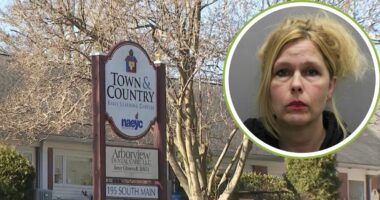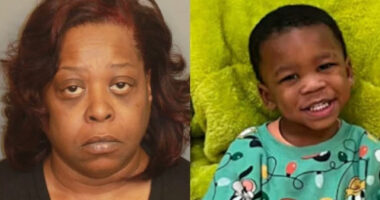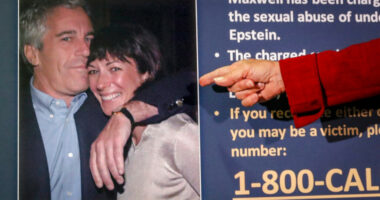Excavators will dig up an Adelaide factory site this weekend in a last-ditch attempt to find the remains of the three missing Beaumont children before the government-owned land is sold to developers.
If the graves of the siblings who vanished from Glenelg Beach on Australia Day in 1966 can finally be located, it will strongly link their presumed murders to suspect Harry Phipps.
The fate of the Beaumont children – nine-year-old Jane, seven-year-old Arnna and four-year-old Grant – remains one of the nation’s most enduring crime mysteries.
Parents Jim and Nancy had entrusted their eldest daughter Jane with looking after her younger siblings on the trip – a five-minute bus journey from their nearby Somerton Park home.
The trio had gone to Wenzel’s Bakery near the beach about midday, where Jane bought pasties and a meat pie with a £1 note her mother later insisted she had not given her.
Witnesses recalled seeing the children happily playing at Colley Reserve in the company of a tall, thin-faced man with short blond hair who appeared to be aged in his 30s.
The disappearance of the Beaumont children is considered to have changed the way Australian parents looked at child safety and marked the end of a more innocent, carefree era.
An earthmoving company has now donated its services for one last excavation of the disused Castalloy foundry which was owned by Phipps when Jane, Arnna and Grant were last seen.

Excavators will dig under an Adelaide factory in a last-ditch attempt to find the remains of the three missing Beaumont children before the government-owned site is sold to developers. Jane, 9, Arnna, 7, and Grant, 7, disappeared from Glenelg Beach on January 26, 1966

An earthmoving company has donated its services for one last excavation of the disused Castalloy foundry (above) which was owned by businessman Harry Phipps when Jane, Arnna and Grant were last seen alive
Digging will begin on Saturday on the land at North Plympton in Adelaide’s inner south-western suburbs – a 10 minute drive from Glenelg – and is expected to take about a week to finish.
Two previous searches of the same location did not yield any evidence of the children’s remains,
However this time, the excavators will dig deeper.
Another possible site at the factory has also been identified which will also be carefully investigated.
Phipps became a prominent suspect after the publication of Alan Whiticker and Stuart Mullins’s book The Satin Man: Uncovering the Mystery of the Missing Beaumont Children in 2013.
The book did not name Phipps – a wealthy businessman who died aged 86 in 2004 – but his estranged son Hayden had first nominated his father as the kidnapper in 2007.
Hayden Phipps also claimed his father, who had what has been called a ‘peculiar predilection for satin’, physically and sexually abused him as a child.
When the Beaumont children went missing, Phipps was living on the corner of Augusta and Sussex Streets in Glenelg, just 300m from the beach.
Hayden, who was 15 at the time, said he had seen Jane, Arnna and Grant in his father’s backyard on that fateful Wednesday, January 26.

Witnesses recalled seeing the Beaumont children happily playing at Colley Reserve in the company of a tall, thin-faced man with short blond hair who appeared to be aged in his 30s. Pictured above is a police sketch of that man

If the graves of the siblings who vanished from Glenelg beach on Australia Day in 1966 can finally be located it will strongly link their presumed murders to suspect Harry Phipps (above)
Two brothers separately claimed that as youths, they had been paid by Phipps to dig a hole two metre long and one metre wide at his factory for unspecified reasons on the Australia Day weekend.
The business had been closed over the holiday period and only Phipps had access to the Mooringe Avenue factory.
A small section of the site was explored in November 2013 when ground-penetrating radar detected an anomaly which might have indicated objects within the soil.
Further digging revealed nothing of significance and the search operation was closed.
Detectives returned to the factory in February 2018 after a private investigation sponsored by Channel Seven but after digging down about 1.5m uncovered only rubbish and animal bones.
Detective Superintendent Des Bray said back then, there was nothing left to do at the site.
‘I can confirm that we have searched the areas of interest and reached the bottom of those areas and gone well below so that we can be 100 per cent certain,’ he told reporters.
‘Sadly this means for the Beaumont family that we still have no answers. But we will always do anything humanly possible to locate the Beaumont children and take them home to their family.’

Two brothers claimed that as youths they had been paid by Phipps to dig a hole 2m-long and 1m-wide at his factory (above) for unspecified reasons on the Australia Day weekend
Before that search began, police confirmed Phipps was a person of interest in the children’s disappearance, along with about a dozen others.
‘It’s probably had more people nominated as a potential offender than any other case that I’m aware of,’ Det Supt Bray said.
After the February 2018 search, Phipps’s younger son Wayne said his brother Hayden, who died in 2016, had been mentally ill and made up the allegations against their father.
‘This is wrong,’ Wayne Phipps told the Sunday Mail newspaper.
‘It’s hurting those who I care about and the memory of those who I cared about. We loved Harry and believe in his innocence.’
The fresh search has been driven by South Australian upper house independent MP Frank Pangallo, who, as a journalist covered the case for Seven’s Today Tonight show.
Mr Pangallo gained approval from the state government and South Australia Police (SAPOL) to have one more attempt at finding the children’s remains after ‘compelling new evidence’ was discovered.
Local businessman Flavio Anfiteatro has donated the services and expertise of his family-owned earthmoving company Flavio and Sons Civil to conduct the operation.

Frank Pangallo described the disappearance of the Beaumont children as ‘one of Australia’s greatest unsolved mysteries’
Equipment will be used to dig deeper at the two previously excavated spots as well as a third area that had never been searched.
‘The new evidence indicates previous digs on the former Castalloy factory site didn’t go deep enough – so that is the intention of the new search,’ Mr Pangallo said.
‘Another possible site has also been identified which will also be part of the new search.
‘While we are hopeful the new search will help solve the mystery, it’s also important to discount the site as the children’s burial ground if we can.’
Mr Pangallo spearheaded calls for another evacuation of the site after he received ‘startling new information’ about the cold case.
‘When I spoke to this person, it blew me away. I’ve never heard this information before,’ he said.
He described the disappearance of the Beaumont children as ‘one of Australia’s greatest unsolved mysteries’.
‘I hope this new search will bring some sort of closure to their long suffering families after nearly 60 years,’ he said.
‘If it doesn’t, at least we know we have tried and car rule out that site once and for all.
‘The government-owned site is about to sold off for development so this search will be the last opportunity to search the area where those closes to the case believe their bodies were buried before new industrial or residential developments are built.’

Digging will begin on Saturday at North Plympton in Adelaide’s inner south-western suburbs – a ten-minute drive from Glenelg. Police and volunteers are pictured at the previous 2018 search
The digging crew will be joined by anthropologist and anatomist Maciej Henneberg, university students and an archaeological scientist.
Mr Pangallo said eyewitness accounts of the factory site along with photographs taken in 1966 had been compared with how it looked now.
Those comparisons revealed the area searched in 2018 had at some time since 1966 been covered with at least an extra 1.5m of soil. That view was supported by Professor Kenneth Olson, a soil science expert from the University of Illinois.
‘Much expertise and science has gone into identifying the new locations for the fresh dig,’ Mr Pangallo said.
‘As such, there is renewed hope that the children’s tragic plight will finally be revealed.
‘To finally be able to bring an end to one of the country’s most baffling and heart-breaking mysteries would be an outstanding – albeit tragic – outcome.
‘That is why the government, SAPOL, government agencies, academics and other people have all been so supportive and co-operative in ensuring this excavation is undertaken.’
Police said they had been kept apprised of the search plans and the ‘rationale for the renewed activity’.

Harry Phipps emerged as a suspect after the publication of Alan Whiticker and Stuart Mullins’s book The Satin Man: Uncovering the Mystery of the Missing Beaumont Children in 2013
‘The individuals conducting the fresh excavation at the site are following a theory that SAPOL believes is not supported by evidence and available information,’ a spokesperson said.
‘SAPOL will monitor the excavation as it proceeds.’
Apart from Phipps, among the main suspects in the Beaumont children’s likely kidnapping are Bevan Spencer von Einem, Derek Edward Percy, Arthur Stanley Brown and James Ryan O’Neill.
Von Einem is a depraved sex killer serving life for the 1984 torture and murder of 15-year-old Richard Kelvin, the son of Adelaide newsreader Rob Kelvin. An informant claimed von Einem confessed to killing the Beaumonts to conduct ‘experiments’.
Child killer Percy was Victoria’s longest-serving prisoner when he died in 2013. In 1970 he had been found not guilty of murdering 12-year-old Yvonne Tuohy in Victoria by reason of insanity and was remanded indefinitely.
Percy admitted being at Glenelg beach on a family trip on the day the Beaumont children went missing when he was 17 but denied any involvement in their disappearance.
Brown was charged in 1998 with the 1970 murders of sisters Judith and Susan Mackay, aged seven and five respectively, who were strangled in Townsville. He was was found unfit to stand trial due to dementia and died in 2002.
Brown bore strong resemblance to a police sketch of the Beaumont suspect but was 53 at the time of their disappearance.

Nancy Beaumont (right) died in September 2019 aged 92. Jim Beaumont (left) died in April 2023 aged 97
O’Neill is a suspected serial killer serving life for the 1975 murder of nine-year-old Ricky Smith in Tasmania. He reported told several acquaintances he was responsible for kidnapping the Beaumont children.
If anything is found at the Castalloy foundry, it will come too late for Jane, Arnna and Grant’s parents. Having lived in hope the children might one day return home, the couple separated in the early 1970s.
Nancy Beaumont died in September 2019 aged 92. Jim Beaumont died in April 2023 aged 97.
A $1million reward still remains on offer for information which finally solves the mystery of the Beaumont children’s disappearance.









